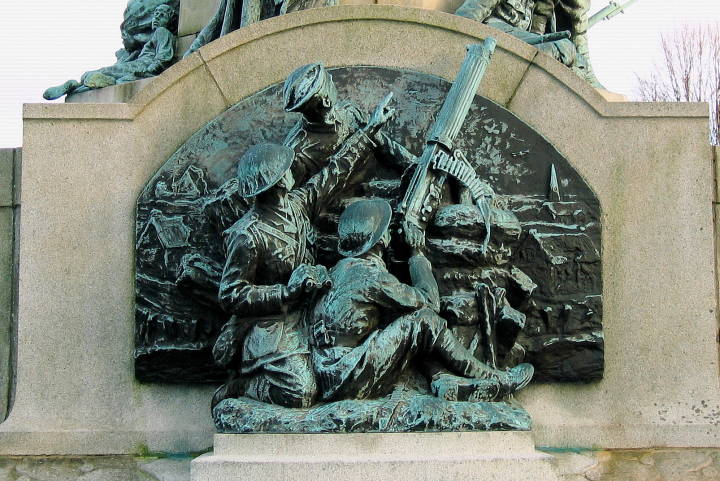
The Port Sunlight War Memorial ("The Defence of the Home") by Sir William Goscombe John. 1916-1921. [Detail] Large circular granite structure with a central marble cross, groups of bronze freestanding figures, and bas-reliefs. Port Sunlight, on the Wirral.
Few English villages can be without a war memorial, but Port Sunlight and its memorial are both unique. Port Sunlight is the model village built from the late Victorian period onwards” by William Lever (later Lord Leverhulme), for the employees at his Sunlight Soap Factory; and its war memorial was designed and sculpted” by his friend Goscombe John, one of the most important of the New Sculptors. Raised on a circular mound at the heart of the village, the memorial honours those of Lord Leverhulme's employees who fell in the Great War, remembering as well the various services that supported them.


Left to right: (a) Distant view of the monument. (b) Three groups: the wounded solder, woman and children, and young girls representing growing food on the home front. [Click on images to enlarge them.]
Taking as its theme "defence of home and country," it also, unusually, shows a number of women and children.

Inclusive and humane, it is supremely naturalistic: the central cross is surrounded” by several groups of greater than life-size figures: "Soldiers guard women and children and a wounded comrade whom a nurse is about to tend; a seated woman cradles a group of infants, and a frightened little girl stands, guarded” by her equally frightened but brave and defiant younger brother; a Boy Scout stands with the soldiers" (Hubbard and Shippobottom 79). Between the wide steps leading down to the road are low walls or ramparts, sporting dramatic bas-reliefs of sailors, anti-aircraft personnel, ambulance-men and gunners. And at the edges of the wall, beside the steps, are narrower bas-reliefs of children bearing wreaths or garlands for the dead. "The overall effect is not of a continuing narrative," writes one commentator aptly, "but of a juxtaposition of action and symbolic scenes, giving a whole dramatic coherence" ("War Memorial ['The Defence of Home']." With many touching elements, this memorial is, perhaps, John's most moving work; yet it is also vigorous, purposeful and inspirational.


Left to right: (a) Anti-aircraft machine gunners. (b) Infantry machine gunner group.


Left: Soldiers supporting a wounded or dying comrade. Right: Two soldiers at the base of the cross, protecting the children and wounded.
As for the children, the boy scout can be seen half-hidden behind the soldier on the left, while the younger boy and his big sister peer out from behind the soldier on the right. Below them in the centre is a bas-relief of sailors on the look-out, with the ship's funnel on the left and the helmsman on the right.
First Photograph by Man vyi, from Wikimedia Commons, 2008, on the Creative Commons license (to be attribiuted). Subsequent Photographs by Robert Freidus. You may use these images without prior permission for any scholarly or educational purpose as long as you link your document to this URL in a web document or cite the Victorian Web in a print one.
Bibliography
Hubbard, Edward, and Michael Shippobottom. A Guide to Port Sunlight Village, Including Two Tours of the Village. 2nd ed. Liverpool: Liverpool University Press, 2006.
"War Memorial ('The Defence of the Home')." PMSA (Public Monument and Sculpture Association site). Viewed 31 July 2009; link updated 31 July 2017.
Created 31 July 2017
Last modified 12 February 2020